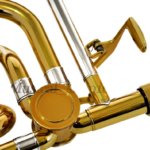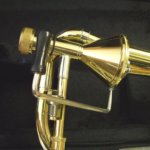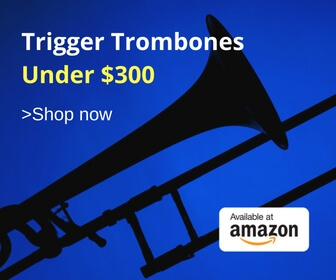When you are looking at a trigger trombone, it’s critical to understand what you’re looking at. Here’s a breakdown of the different attributes of an f-attachment and what they can do for you.
Open or Closed (Traditional) Wrap?
The tubing in an F-attachment is going to be referred to as either having a closed wrap or an open wrap.
A closed wrap, sometimes referred to as traditional wrap, trigger trombone keeps all the extra tubing confined within the bell section of the trombone.
Closed Wrap Trigger Trombones on Amazon
An open wrap trigger trombone allows the tubing to beyond the crook of the bell section.
Open Wrap Trigger Trombones on Amazon
So which is better? Most trombonists, particularly professional trombonists, say that the overall playability of an open wrap is better because the air flow through the horn is less restricted. There are simply fewer bends in an open wrap that the air must flow through than in a closed wrap.
However, a closed wrap enthusiast may say that a well constructed trombone with a closed wrap can have just as good an airflow as an open wrap. Still, a closed wrap will always have more bends in the tubing than an open wrap.
There is one very good reason to have a closed wrap trigger trombone: protection from dings and scratches to the tubing or damage to the tuning slide.
Because of the compactness of the closed wrap and the fact that all the tubing is confined within the bell section, it is less exposed to accidents. High school and college trombone players, especially those who will find themselves on the marching field, will probably be better off with a closed wrap trigger trombone. One can always upgrade to an open wrap on the path to professional status.
String or Mechanical Linkage?
There are two types of linkage that open and close the valve on an F attachment: string or mechanical.
A mechanical linkage uses metal arms with ball and socket joints to open and close the valve. Though this type of linkage requires less maintenance than a string, it does make a bit of a clicking noise when used.
Trigger Trombones with Mechanical Linkage in Amazon
A string linkage uses a string to move the parts of the valve when the trigger is depressed. The string is attached to posts and wrapped around parts of the valve to achieve this. Many players prefer string linkage because it is silent when engaged. However, strings do break and need adjusting from time to time.
Types of Valves
The most common type of valve on a thumb operated trigger trombone is the rotary valve (seen left). A rotary valve was used on the first ever trigger trombone developed by Christian Friedrich Sattler in 1839. It has a good ergonomic design and a short throw.
The most common complaint on a rotary valve is its impeded air flow. The angles within the design of the valve are the cause of this. Nonetheless, most trigger trombones are made with the rotary valve because of its durability and ease of maintenance.
New designs on the trigger trombone valve have come out such as the axial flow valve which reduces the angles in which the air flows in and out of the F-attachment. Other proprietary designs which also improve airflow are the Thayer(Bach) and the CL2000 (Conn).
Materials Used to Make Trigger Trombones
Like all brass instruments, a trigger trombone is made from brass (surprise!). Because brass tarnishes easily, it is finished with a lacquer or some other material such as silver or gold plating. Whatever the instrument looks like on the surface, it is almost always brass underneath.
The finish on the horn effects the look, longevity, and sound. A lacquer finish is the least expensive and will start to erode in a few years. However, one can always get a horn re-lacquered. A silver or gold finish is going to be more expensive but will last a lot longer than plain lacquer. Since lacquer is thicker than silver or gold plating, it is said to give the instrument a richer, mellower sound. A silver finish makes the sound clearer and crisper.
There are different types of brass and that do affect the sound of the horn. The most common kind of brass, containing about 70 percent copper, is yellow brass. Brass with a higher copper content is referred to as rose brass and if it has a really high copper content it may be called red brass.
Rose Brass Trigger Trombones on Amazon
Oftentimes, the bell section of a horn is made from a higher quality brass than the rest of the horn. For example, there are models of trombone that use yellow brass for the slide and rose brass for the bell. The redder the brass, the darker and warmer the sound will be. There are trombones with bell sections made of solid silver which give the instrument a much brighter sound.
Some parts of a trombone may be made from nickel. Inner slides, trim, and replaceable parts such as the water key are often made from nickel.
Trigger Trombone Slide Positions
Click here for slide position chart.
Trigger Trombone Slide Positions Demonstrated
Buying a Trigger Trombone Online
There is one disadvantage to buying a musical instrument online: it is not like walking into a store and being able to try out several instruments at once. However, there are advantages to buying your trigger trombone online:
- For those of you who do not live a few blocks or a few miles from a musical instrument store, there is a universe of trigger trombones for sale just a mouse click away from reputable sellers.
- Many musical instrument stores do not have a wide selection of trigger trombones and only carry a couple of specific brands and models. Online, you can select from every brand and model.
- The best prices for a new or used instrument by far are online. Online sellers do not bear the burden of overhead like brick and mortar store sellers do and can offer their instruments at a more affordable price. Stiffer competition on the internet also drives online prices.
How to Evaluate a Trigger Trombone Listing
- Do not buy from a seller who does not offer a refund unless the price is significantly low enough for you to justify taking a risk on getting an instrument that does not perform well. Chances are, a seller who does not offer a refund is hiding something.
- Check the terms of the refund. Be sure the seller gives you a bare minimum of seven days from the time you receive the instrument to try it out and return it if necessary. Also be aware of whether or not you will have to pay shipping and handling fees to return it.
- Look for multiple, up close pictures of the instrument from all angles.
- Contact the seller and have them answer all your questions satisfactorily.
- When buying from an auction or multiple seller site, make sure the seller has a positive rating.
- Before making your final decision, do some research online to determine which trigger trombone is best for you.
Trigger Trombone Recommends:



